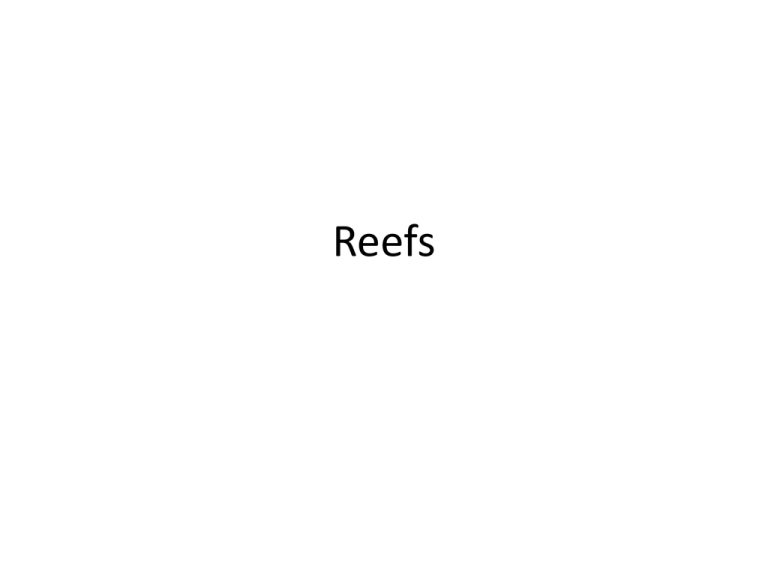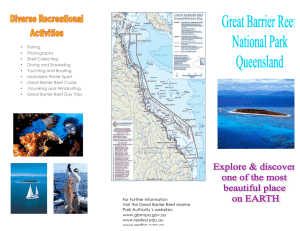Reefs ppt
advertisement

Reefs Modern Reef Structure Factor Energy of Water Temperature Fore Reef Back Reef Low especially in deeper parts, except for storms, turbidity currents High energy where waves break Low to medium Cool water, relatively constant Warm water, variable High, variable Moderate, constant Lots of Depends – could be high photosynthesis, lots of if photosynthesis, could breaking waves – be low if decomp higher O, stable Moderate, constant Variable within bounds Variable: high if evaporation, lower if storms Some mud, some sandy, sometimes unstable Hardground, sandy channels Sandy if higher energy, muddy if low energy Oxygen Level Salinity Substrate (what is the bottom like) Reef Core Zone Advantages Constant environment Forereef Challenges Less sun, colder, debris flows Adaptations Righting orgs, weedy orgs., filter feeders Reef core Lots of oxygen, light, High energy, incoming food particles. somewhat variable Stable bottom, Clamping down orgs., robust skeletons, dome-shaped orgs Back reef Lots of sunlight, possibly lots of oxygen, warm, lower energy Smaller, more delicate orgs., photosynthesizing, adapted to changing conditions Could be low oxygen, interacts with terrestrial env., variable temp & salinity Now let’s look at a Permian reef Guadalupe Reef, Permian Basin, Texas All images from Scholle, Goldstein & Ulmer-Scholle, 2007, Open File Report 504, New Mexico Bureau of Geology and Mineral Resources A B C D E F G A C E B D F G A: Redbeds and Evaporites What do redbeds and evaporites tell us about environment? Redbeds: terrestrial deposition; Evaporites: restricted circulation (reef is blocking incoming ocean water) A B C D E F G A C E B D F G B: Lagoonal Mudstones What does the presence of stromatolites tell us about the environment? Stromatolites mean nobody is eating the algae, not even snails. So unusual water chemistry (probably too saline, and that is confirmed by the dolomite and evaporites) A B C D E F G A C E B D F G C&D: Pisolites & Grainstones C&D: Pisolites & Grainstones (cont) What do pisolites and cross-beds tell us about the environment? Pisolites = shoaling (waves sloshing back and forth) or tidal motion causing sediment to roll. Cross-beds = current A B C D E F G A C E B D F G E: Reef Core There are no Permian corals that build big frameworks, so the reef is built from other organisms: here it’s algae. E: Reef Core These are crosssections through the sponge framework of the reef. Reconstruction of reef core Sponges, algae, corals and corallike creatures, bryozoans, echinoderms (cystoids, crinoids) A B C D E F G A C E B D F G F: Upper Reef Slope F: Lower Reef Slope A B C D E F G A C E B D F G G: Basinal Deposits Turbidites cascaded down the reef slope into the basin. Coarse grained layers are channels; finer grained are the farther edges of a flow or the finer materials that spilled over the channel lip (overbank deposits). G: Basinal Deposits Turbidites at the bottom edge of the fans Very fine-grained limestone in the basin






